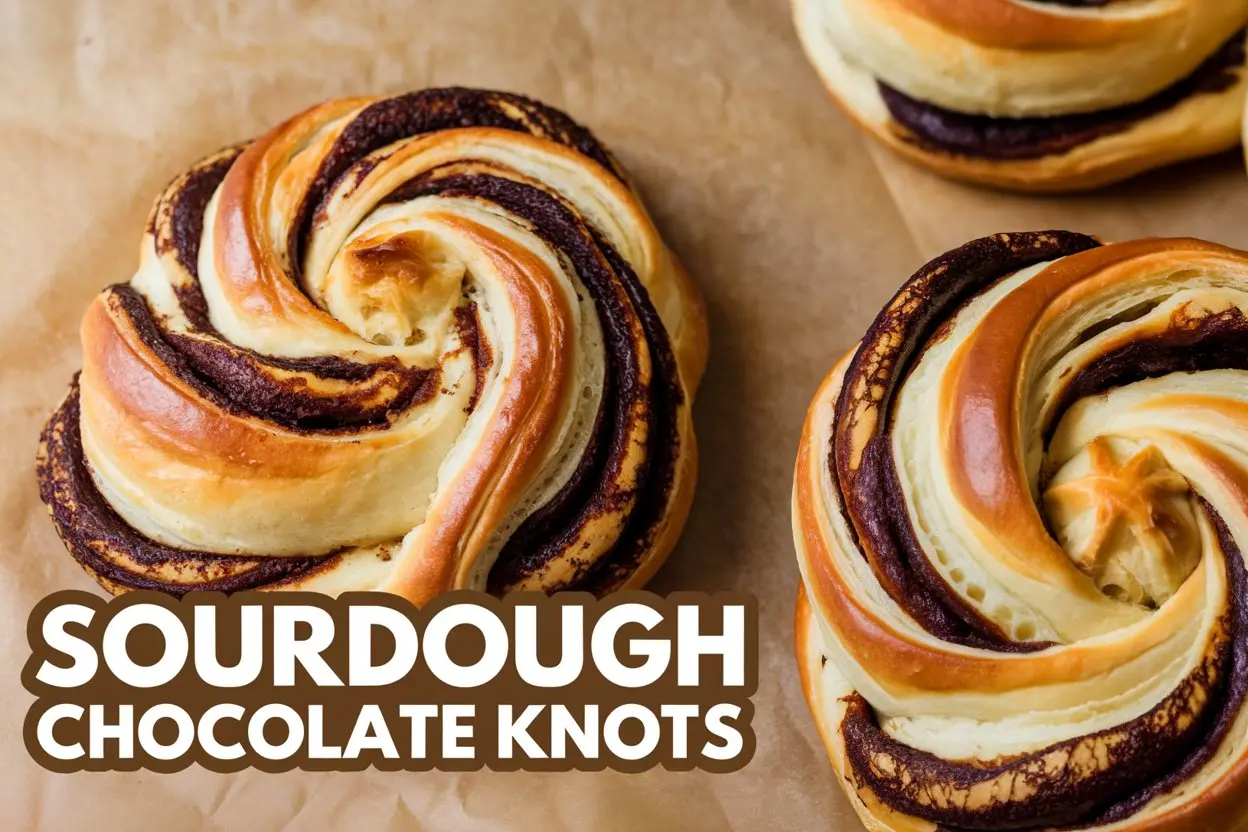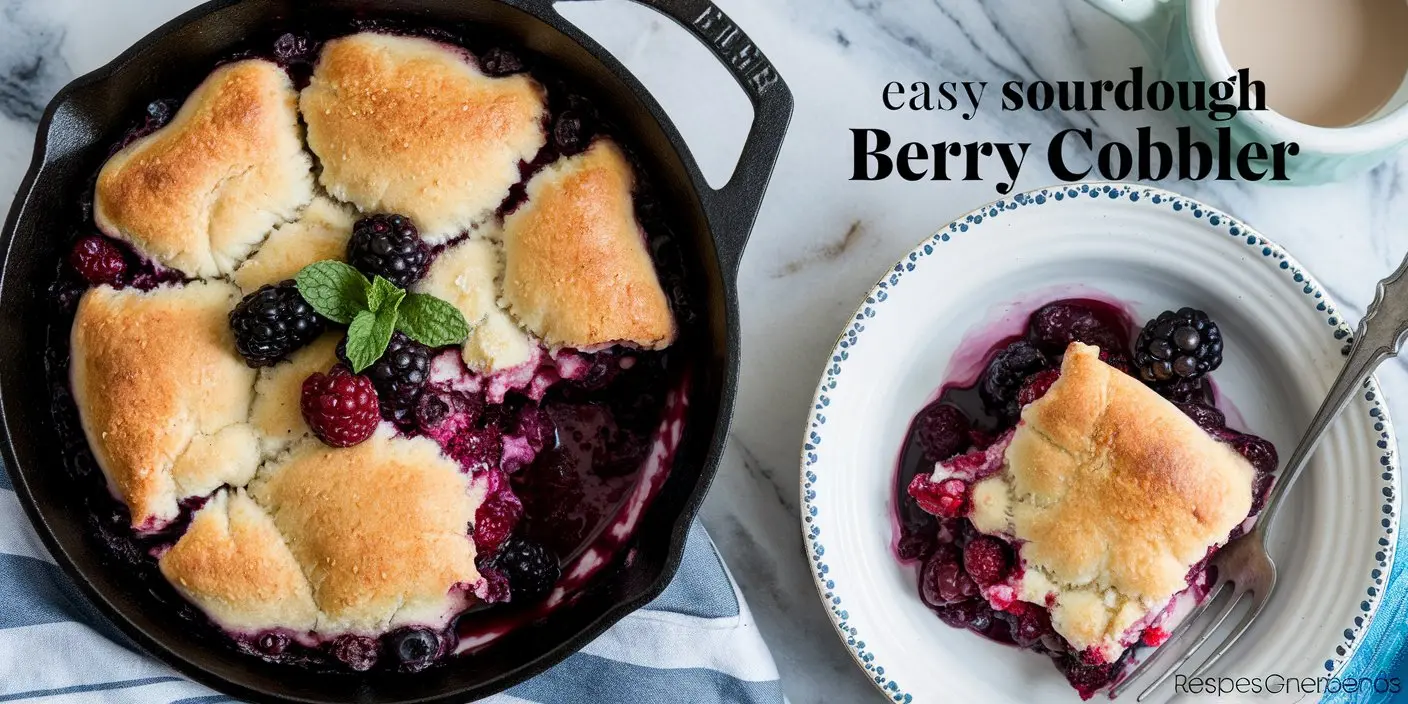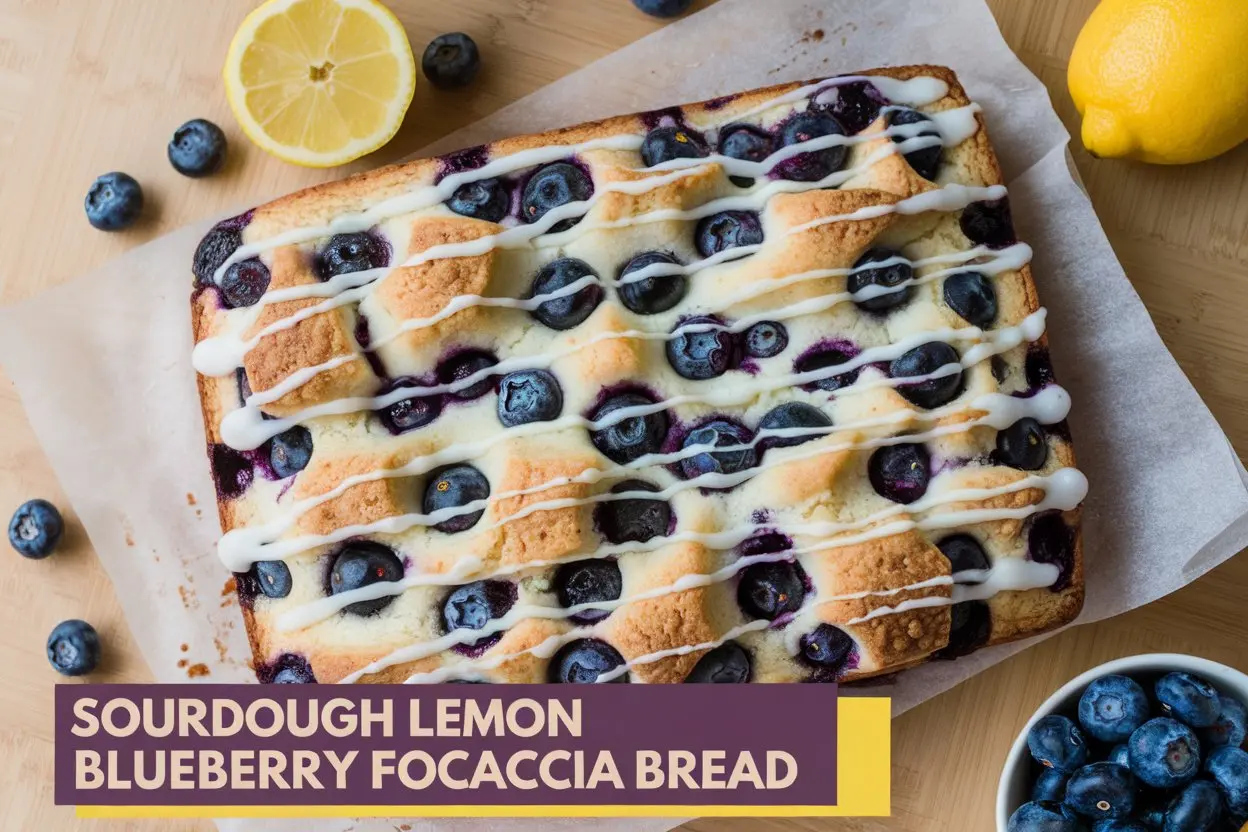
Imagine biting into a piece of freshly baked focaccia bread, its crust golden and crisp, the interior soft and airy. Now, elevate that experience with the zesty brightness of lemon and the sweet burst of fresh blueberries. Intrigued? Let’s dive into the delightful world of 🍞🍋Sourdough Lemon Blueberry Focaccia Bread🍞💜.
The Allure of Sourdough Baking
Sourdough baking isn’t just a method; it’s a journey. Harnessing wild yeast and bacteria, sourdough offers a depth of flavor and a texture that’s hard to beat. Plus, it’s easier to digest due to the fermentation process breaking down gluten and phytic acid in the flour. If you’re new to sourdough, this recipe is a fantastic way to start, combining the basics with a flavorful twist.
Equipment
- Mixing Bowl: A large bowl to combine your ingredients.
- Kitchen Scale: For precise measurements, ensuring consistency in your bake.
- Dough Scraper: Assists in handling and folding the dough efficiently.
- 9×13-inch Baking Pan: Provides the ideal dimensions for focaccia, allowing for even baking and a desirable crust.
- Parchment Paper: Prevents sticking and makes for easy cleanup.
- Citrus Zester and Juicer: Essential for extracting fresh lemon zest and juice, infusing the bread with vibrant flavor.
- Measuring Cups and Spoons: For accurate measurement of smaller quantities.
- Clean Kitchen Towel or Plastic Wrap: To cover the dough during proofing, maintaining moisture and preventing a dry crust.
Ingredients Breakdown
Before we get our hands doughy, let’s gather our ingredients:
- Active Sourdough Starter: 100g (about 1/2 cup)
- Alternative: If you don’t have a sourdough starter, you can substitute with commercial yeast. For 100g of starter, replace with 50g of flour, 50g of water, and a small amount of yeast (about 5g). Let this mixture sit until bubbly before use.
- Use: Provides natural leavening and imparts a unique tangy flavor to the bread.
- Warm Water: 400g (1 2/3 cups)
- Alternative: Milk or dairy-free milk alternatives can be used to add richness to the dough.
- Use: Hydrates the flour, activating gluten development and aiding in fermentation.
- Granulated Sugar: 50g (1/4 cup)
- Alternative: Honey or maple syrup can be used in equal amounts for a different flavor profile.
- Use: Feeds the yeast, enhancing fermentation, and adds sweetness to balance the tartness of the lemon.
- Salt: 10g (2 teaspoons)
- Alternative: Sea salt or kosher salt can be used; adjust the quantity to taste.
- Use: Enhances overall flavor and strengthens the dough’s gluten structure.
- Bread Flour: 500g (4 cups)
- Alternative: All-purpose flour can be used, but the bread may have a slightly less chewy texture due to the lower protein content.
- Use: Provides the necessary protein (gluten) for structure and chewiness in the bread.
- Fresh Lemon Juice: 3 tablespoons (from 1 large lemon)
- Alternative: Bottled lemon juice can be used in a pinch, but fresh juice offers a brighter flavor.
- Use: Adds acidity and a refreshing citrus flavor that complements the sweetness of the blueberries.
- Lemon Zest: 3 teaspoons (from 1 large lemon)
- Alternative: Lemon extract can be used; however, adjust the quantity as it’s more concentrated.
- Use: Provides intense lemon flavor and aromatic oils, enhancing the bread’s fragrance.
- Fresh Blueberries: 1 cup
- Alternative: Frozen blueberries can be used; do not thaw them before adding to prevent excess moisture.
- Use: Adds bursts of sweetness and a pleasant texture contrast within the bread.
- Unsalted Butter, Melted: 62g (1/4 cup)
- Alternative: Olive oil or plant-based butter substitutes can be used for a dairy-free option.
- Use: Adds richness and moisture to the bread, contributing to a tender crumb.
- Olive Oil: 30g (2 tablespoons, for pan preparation)
- Alternative: Vegetable oil or melted butter can be used to grease the pan.
- Use: Prevents the dough from sticking to the pan and helps in achieving a crispy crust.
For the Glaze:
- Fresh Lemon Juice: 2-3 tablespoons
- Alternative: A mixture of lemon extract and water can be used if fresh lemons are unavailable.
- Use: Provides a tangy base for the sweet glaze, enhancing the lemon flavor.
- Powdered Sugar: 130g (1 cup)
- Alternative: A blend of granulated sugar and cornstarch processed together can substitute if powdered sugar is unavailable.
- Use: Sweetens the glaze, balancing the tartness of the lemon juice and adding a smooth finish to the bread.
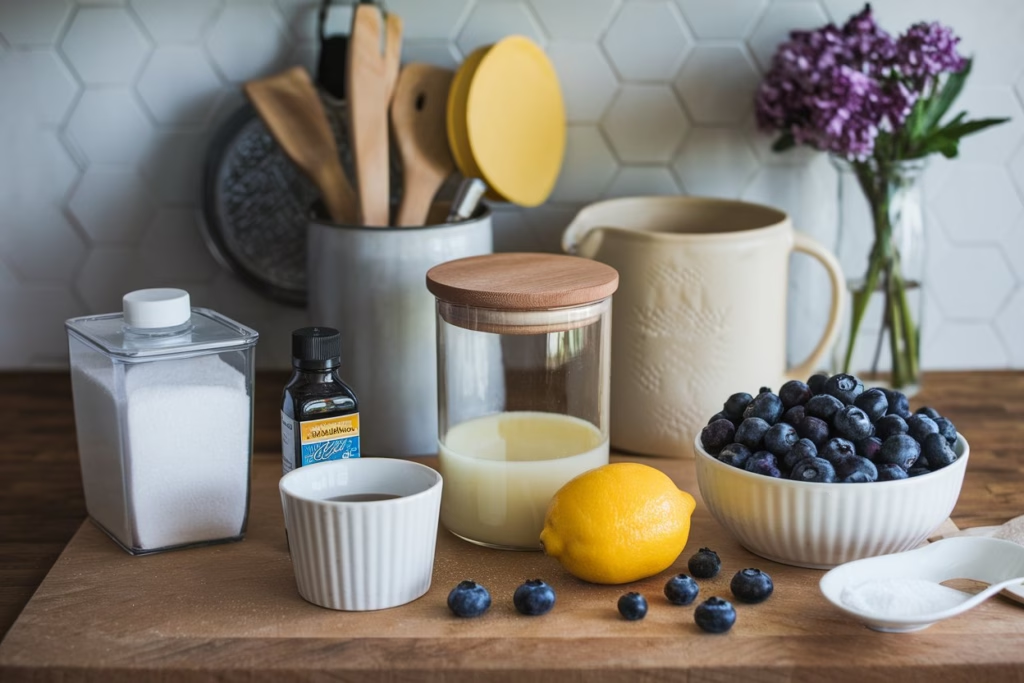
Step-by-Step Baking Guide
1. Preparing the Sourdough Starter
Feed your sourdough starter 4-6 hours before mixing the dough. This ensures it’s at peak activity, full of bubbles and ready to leaven your bread.
2. Mixing the Dough
In a large bowl, combine:
- 100g active sourdough starter
- 500g bread flour
- 400g warm water
- 50g granulated sugar
- 10g salt
- 3 tablespoons fresh lemon juice
- 3 teaspoons lemon zest
Stir until a shaggy dough forms. Cover and let it rest for 30 minutes to allow the flour to hydrate.
3. Stretch and Fold
Perform a series of stretches and folds to develop the dough’s gluten structure:
- With wet hands, lift one edge of the dough and fold it over itself.
- Rotate the bowl 90 degrees and repeat.
- Continue this process four times (a full rotation).
Repeat this set of stretches and folds three times, with 30-minute rests in between. You’ll notice the dough becoming more elastic and smooth.
4. Bulk Fermentation
After the final fold, cover the bowl and let the dough rise at room temperature for 3-6 hours. Look for visible expansion and air bubbles on the surface—a sign that fermentation is in full swing.
5. Cold Fermentation
Transfer the covered bowl to the refrigerator and let it ferment overnight. This slow fermentation enhances the bread’s flavor and texture.
6. Preparing the Baking Pan
The next day, line a 9×13-inch baking pan with parchment paper. Drizzle 30g of olive oil evenly over the bottom to prevent sticking and add flavor.
7. Shaping the Dough
Gently turn the dough out into the prepared pan. With oiled fingers, softly stretch and press the dough to fit the pan’s dimensions. Cover and let it rise in a warm place for 4-5 hours until puffy and bubbly.
8. Adding Toppings
Preheat your oven to 400°F (200°C).
- Sprinkle 1 cup of fresh blueberries evenly over the dough.
- Pour 62g of melted unsalted butter on top.
- Using your fingertips, create dimples across the surface, pressing the blueberries slightly into the dough.
9. Baking the Focaccia
Bake for 30-40 minutes until the top is light golden brown and the internal temperature reaches 200°F (93°C). The aroma will be irresistible!
10. Preparing the Lemon Glaze
While the focaccia cools, whisk together 130g of powdered sugar and 2-3 tablespoons of fresh lemon juice until smooth. Adjust the consistency as needed; it should be pourable but not too runny.
11. Glazing the Bread
Once the focaccia has cooled to room temperature, drizzle the lemon glaze over the top. This adds a sweet-tart finish that complements the rich dough and juicy blueberries.
Baking Schedule
To help you plan, here’s a sample timeline:
Day 1:
- 8:00 AM: Feed your sourdough starter.
- 1:30 PM: Mix the dough by combining active sourdough starter, bread flour, warm water, granulated sugar, salt, lemon juice, and lemon zest. Stir until a shaggy dough forms. Cover and let rest for 30 minutes.
- 2:00 PM: Perform the first set of stretches and folds.
- 2:30 PM: Second set of stretches and folds.
- 3:00 PM: Third set of stretches and folds.
- 3:00 PM – 9:00 PM: Allow the dough to bulk ferment at room temperature until it has visibly expanded and shows air bubbles on the surface.
- 9:00 PM: Transfer the covered bowl to the refrigerator for overnight cold fermentation.
Day 2:
- 7:00 AM: Prepare a 9×13-inch baking pan by lining it with parchment paper and drizzling olive oil evenly over the bottom.
- 7:15 AM: Turn the dough out into the prepared pan. With oiled fingers, gently stretch and press the dough to fit the pan. Cover and let it rise in a warm place for 4-5 hours, until puffy.
- 12:15 PM: Preheat the oven to 400°F (200°C).
- 12:30 PM: Sprinkle fresh blueberries over the dough and pour melted butter evenly on top. Using your fingertips, create dimples across the surface of the dough.
- 12:35 PM: Bake the focaccia for 30-40 minutes, until the top is light golden brown and the internal temperature reaches 200°F (93°C).
- 1:15 PM: While the bread cools, prepare the glaze by whisking together powdered sugar and lemon juice until smooth.
- 1:30 PM: Once the focaccia has cooled to room temperature, drizzle the lemon glaze over the top.
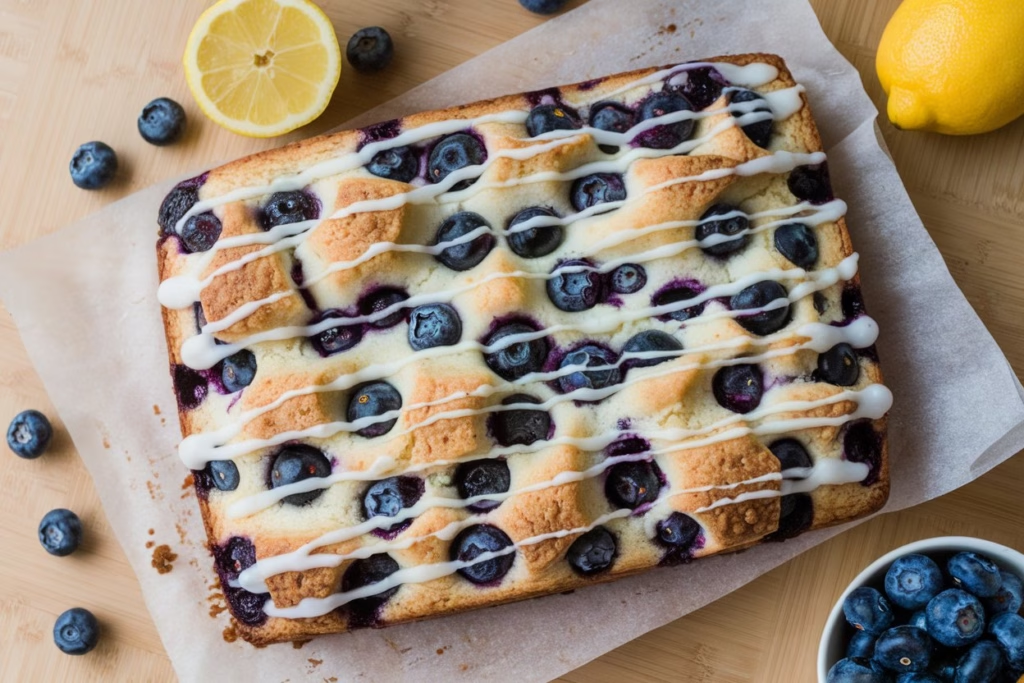
Tips for Success
- Active Starter: Ensure your sourdough starter is at its peak activity before using it in the recipe.
- Temperature Control: The ambient temperature can affect fermentation times. Warmer environments speed up fermentation, while cooler ones slow it down.
- Fresh Ingredients: Use fresh lemons for juice and zest to achieve the best flavor.

What to Serve with It?
This delightful focaccia pairs wonderfully with a variety of dishes:
- Breakfast or Brunch: Serve slices alongside scrambled eggs, crispy bacon, or a fresh fruit salad for a balanced meal.
- Cheese Platter: The tangy lemon and sweet blueberries complement a selection of cheeses, such as brie, goat cheese, or sharp cheddar.
- Salads: Pair with a crisp green salad dressed in a light vinaigrette to balance the richness of the bread.
- Dessert: Enjoy a slice with a dollop of whipped cream or a scoop of vanilla ice cream for a sweet treat.
How to Store
To maintain the freshness and flavor of your focaccia:
- Room Temperature: Once cooled, place the focaccia in an airtight container or wrap it tightly in plastic wrap. Store at room temperature for up to 2 days.
- Refrigeration: For extended freshness, refrigerate the wrapped focaccia for up to a week. Note that refrigeration may alter the texture slightly.
- Freezing: To enjoy at a later date, slice the focaccia and place pieces in a freezer-safe bag or container. Freeze for up to 3 months. When ready to eat, thaw at room temperature and reheat in the oven at 350°F (175°C) for about 10 minutes to restore its original texture.

Embarking on the journey of baking Sourdough Lemon Blueberry Focaccia Bread is a rewarding experience that combines the tangy zest of lemon with the sweet burst of blueberries, all nestled in the comforting embrace of sourdough. With patience and attention to detail, you’ll create a delightful bread that’s perfect for any occasion. Happy baking!
FAQs
Can I skip the overnight cold fermentation?
The cold fermentation develops the bread’s flavor. Skipping it may result in a less complex taste.
How do I know when the Focaccia dough has bulk fermented enough?
The dough should have visibly expanded and show air bubbles on the surface, indicating active fermentation.
Can I use frozen blueberries in Lemon Blueberry Focaccia Bread?
Yes, you can use frozen blueberries. Thaw and drain them before adding to the dough to prevent excess moisture.

🍞🍋 Sourdough Lemon Blueberry Focaccia Bread: A Delightful Twist on a Classic 🍞💜
- Total Time: 1 day 4 hours 35 minutes
- Yield: 12
Description
Discover the perfect blend of tangy lemon and sweet blueberries in this sourdough focaccia bread. Elevate your baking game with this unique and flavorful recipe!
Ingredients
- 100g active sourdough starter (about 1/2 cup)
- 400g warm water (1 2/3 cups)
- 50g granulated sugar (1/4 cup)
- 10g salt (2 teaspoons)
- 500g bread flour (4 cups)
- 3 tablespoons fresh lemon juice (from 1 large lemon)
- 3 teaspoons lemon zest (from 1 large lemon)
- 1 cup fresh blueberries
- 62g unsalted butter, melted (1/4 cup)
- 2–3 tablespoons fresh lemon juice (for glaze)
- 130g powdered sugar (1 cup, for glaze)
- 30g olive oil (2 tablespoons, for pan preparation)
Instructions
- Prepare the Starter: Feed your sourdough starter 4-6 hours before mixing the dough, allowing it to reach peak activity.
- Mix the Dough: In a large bowl, combine active sourdough starter, bread flour, warm water, granulated sugar, salt, lemon juice, and lemon zest. Stir until a shaggy dough forms. Cover and let rest for 30 minutes.
- Stretch and Fold: Perform a set of stretches and folds by lifting and folding the dough over itself, rotating the bowl each time. Repeat this process three times, with 30-minute rests in between, until the dough becomes elastic.
- Bulk Fermentation: Cover the bowl and let the dough rise at room temperature for 3-6 hours, until it has visibly expanded and shows air bubbles on the surface.
- Cold Fermentation: Transfer the covered bowl to the refrigerator and let it ferment overnight.
- Prepare the Pan: The next day, line a 9×13-inch baking pan with parchment paper and drizzle olive oil evenly over the bottom.
- Shape the Dough: Turn the dough out into the prepared pan. With oiled fingers, gently stretch and press the dough to fit the pan. Cover and let it rise in a warm place for 4-5 hours, until puffy.
- Add Toppings: Preheat the oven to 400°F (200°C). Sprinkle fresh blueberries over the dough and pour melted butter evenly on top. Using your fingertips, create dimples across the surface of the dough.
- Bake: Bake the focaccia for 30-40 minutes, until the top is light golden brown and the internal temperature reaches 200°F (93°C).
- Prepare the Glaze: While the bread cools, whisk together powdered sugar and lemon juice until smooth. Adjust consistency as needed.
- Glaze the Bread: Once the focaccia has cooled to room temperature, drizzle the lemon glaze over the top.
- Prep Time: 1 hour 30 minutes
- Cook Time: 35 minutes
Nutrition
- Serving Size: 1 slice
- Calories: 301.45 kcal per serving
- Sugar: 14.42 g
- Sodium: 651.95 mg
- Fat: 11.74 g
- Saturated Fat: 4.92 g
- Unsaturated Fat: 6.21 g
- Trans Fat: 0.26 g
- Carbohydrates: 44.47 g
- Fiber: 0.7 g
- Protein: 4.49 g
- Cholesterol: 16.57 mg

